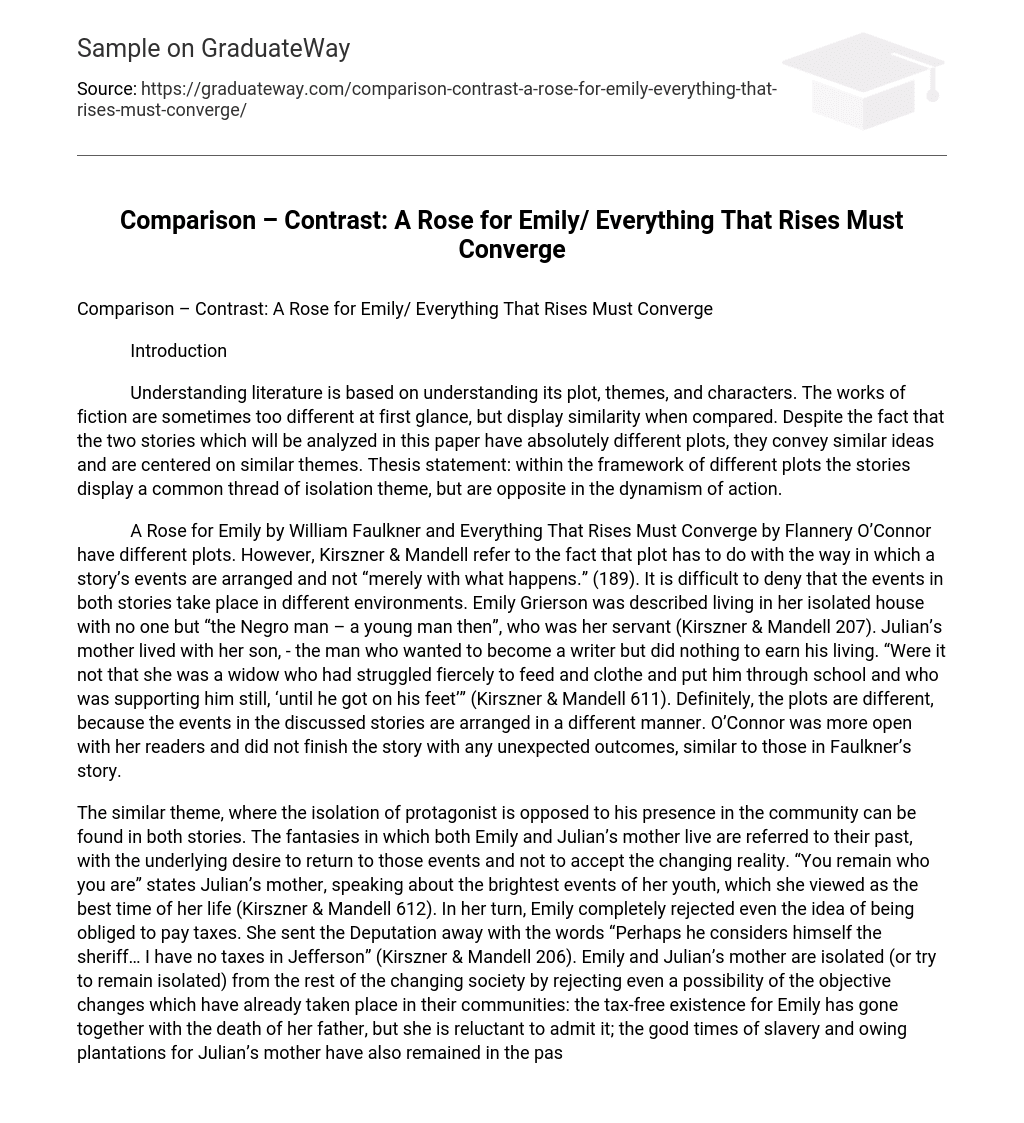Introduction
Understanding literature requires comprehension of its plot, themes, and characters. Although works of fiction may appear dissimilar at first glance, they can exhibit similarities when compared. In this paper, two stories with contrasting plots will be analyzed to demonstrate their shared ideas and themes.
The thesis statement posits that despite having different plots, the stories share a common thread of isolation as a theme. However, they differ in the level of action dynamism.
A Rose for Emily by William Faulkner and Everything That Rises Must Converge by Flannery O’Connor have different plots. However, Kirszner & Mandell refer to the fact that plot has to do with the way in which a story’s events are arranged and not “merely with what happens” (189). It is difficult to deny that the events in both stories take place in different environments. Emily Grierson lived an isolated life in her house with only her servant, a young Negro man (Kirszner & Mandell 207). On the other hand, Julian’s mother lived with him – a man who aspired to be a writer but did nothing for his living. She was supporting him still because she was a widow who had struggled fiercely to feed and clothe him and put him through school (Kirszner & Mandell 611). The plots of these stories differ because their events are arranged differently. O’Connor was more transparent with her readers and did not end her story unexpectedly like Faulkner’s.
Both stories share a similar theme where the protagonist’s isolation conflicts with their presence in the community. Emily and Julian’s mother both fantasize about their past, desiring to return to those events instead of accepting reality. Julian’s mother speaks about her youth as the best time of her life” and believes that “you remain who you are.” Emily, on the other hand, rejects even the idea of paying taxes and sends the Deputation away with the words “I have no taxes in Jefferson.” Both women isolate themselves from society by refusing to acknowledge objective changes that have already taken place. For instance, Emily refuses to accept that her tax-free existence has ended with her father’s death. Similarly, Julian’s mother clings onto memories of slavery and owning plantations despite these times being long gone: “I remember going to Grandpa’s when I was a little girl. Then the house had double stairways that went up to what was really the second floor – all cooking was done on the first.” (Kirszner & Mandell 612-613)
The two women are isolated from the rest of society, and society seems reluctant to accept them with their fantasies and false ideas about the time in which they now live. However, while both authors wanted to convey similar themes, they have arranged the events in their stories in completely different ways.
The line of events in A Rose for Emily” is too monotonous from the very beginning. Faulkner probably wished to reveal Emily’s biggest secret at the end of the story: “Upon a chair hung the suit, carefully folded; beneath it were two mute shoes and discarded socks. The man himself lay on the bed” (Kirszner & Mandell 212). The outcome of the story is so unexpected that readers may misunderstand it through their first reading. A second reading may be necessary to ensure that Faulkner really meant a man’s body was found in Emily’s room.
In contrast, the outcome of O’Connor’s story is at least anticipated. The fact of her being rejected by the new equal and non-racist society is supported by the conflict with a black woman and her son. “All at once she seemed to explode like a piece of machinery that had been given one ounce of pressure too much. Julian saw the black fist swing out with the red pocketbook” (Kirszner & Mandell 620). O’Connor prepared the reader for this or any other similar outcome using every means possible, starting from her description of the black woman: “She was a giant of a woman. Her face was set not only to meet opposition but to seek it out” (Kirszner & Mandell 617), and finishing with Julian’s precautions in an attempt to prevent an incident.
The essence of Faulkner’s story lies in its end; however, O’Connor’s story is characterized by its narration from beginning to end, where she depicts every detail about both Julian and his mother, making it easier for readers to understand their relationship deeply. Everything That Rises Must Converge offers a dynamic description of complicated mother-son relations in new social conditions while A Rose for Emily presents an even and calm narration on human position towards society as a whole.
Despite their differences, it is impossible not to notice how isolated all characters are. Julian did nothing to keep his mother alive or with him; conversely, Emily went above and beyond what was expected in order to keep her man all for herself. Both breached moral norms but failed miserably in achieving happiness.
Conclusion.
The life of a person in changing social conditions is difficult. The happiness of such a person depends on their position towards society and their acceptance or rejection of new norms. Personal ties and relationships also play a significant role in determining or changing this position. Everything That Rises Must Converge” and “A Rose for Emily” are two different plots that convey similar ideas, although they differ in their dynamism. Both stories refer to the same idea of unchangeable human isolation. Interestingly, these stories seem to supplement each other, with their full potential being revealed when they are compared and contrasted.
Works Cited
Kirszner and Mandell’s Literature: Reading, Reacting, Writing Compact is a sixth edition text.
Edition: Heinle, 2006.





